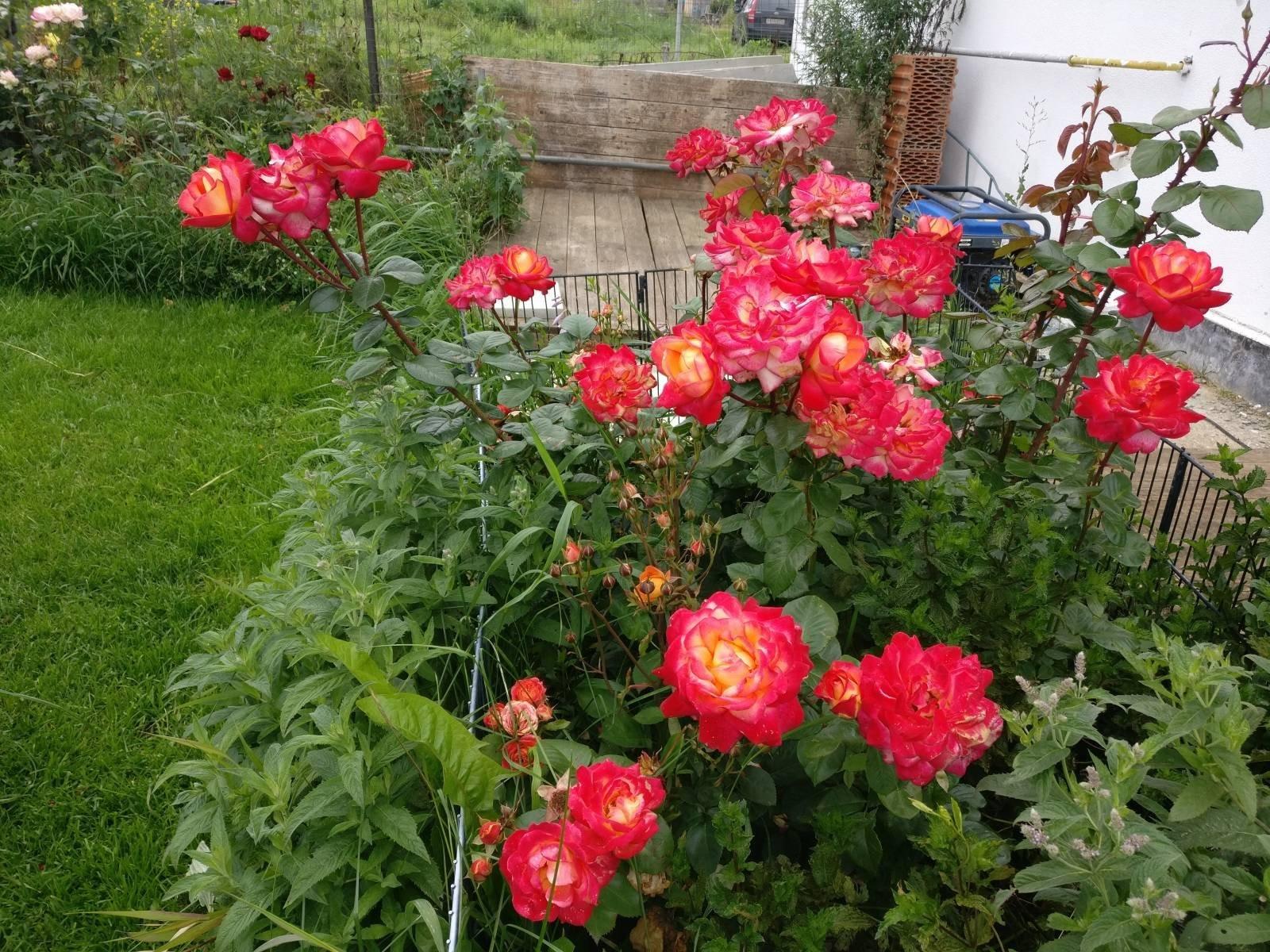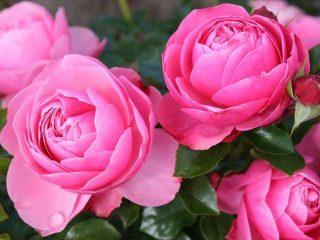Content
Rose Harlequin is a garden plant with a pleasant aroma and lush flowers. The species belongs to the climbing varieties. It will not be possible to grow it in an apartment; open ground is required.
History of selection
The originator of the Harlequin variety is the German company Meilland. The rose was bred in 1986. Harlequin's parent specimens were Zambra, Suspence and Arthur Bell. The result is a unique culture that has no analogues in nature. Due to its high decorative properties, the plant quickly spread to other countries.

Rose Harlequin is an ornamental variety that requires love and care from the owner
Description of the rose variety Harlequin
Harlequin belongs to the shrub varieties. Its main feature is the change of shades. Roses can change color. The variety received the name “Harlequin” in honor of circus performers. The bush has an interesting color palette. Unopened buds have a bright pink tint. During flowering, the petals begin to darken, and a yellowish center forms in their center.
Harlequin is a double plant. The green mass resembles leather and has a glossy surface. Light green foliage is sparsely spaced.This could make the roses less lush if not for the large and bright flowers. The petals are quite soft and moist; decorative lines sometimes run along their surface.
The bush grows high up. It can reach a length of 240 cm. The maximum height of a rose is 290 cm, but this is only possible under certain growing conditions. The branches spread over a width of 110-120 cm. Harlequin forms many branches that do not stop growing throughout its life. Because of this, the species requires pruning. If neglected, Harlequin's thorns will fill the entire garden.
Up to four buds are formed on one branch. The flowers are large, more than 11 cm in diameter, and shaped like a glass. They consist of 28-32 petals and can be arranged in the form of inflorescences or alone. Harlequin is a variety with bright flowering and a pleasant aroma. If you walk past a rose in late spring, you can smell a pleasant fruity scent.

Harlequin roses are very popular in Europe; in Russia they are grown in Moscow and St. Petersburg
Roses bloom twice a year - from May to October. There should be some time between periods. There are very few thorns on the stem, which makes pruning more convenient. The variety is suitable for creating hedges, planting in flower beds, group combinations, and design decoration.
The culture has average resistance to diseases. Powdery mildew practically does not bother her. The shoots are strong and do not deform even in strong winds.
Rose Harlequin prefers loose areas with good permeability. Fertile soils are required for planting.Heat resistance is increased, the culture survives high temperatures well, but at this time it needs plenty of moisture. Frost resistance is also excellent - the rose can withstand temperatures down to -35 °C. If a cold season is expected, you need to take care of shelter.
Pruning is carried out several times a year. In the spring, they cut off the lashes that have suffered in the winter. The frozen tips of the shoots are also removed. After the growing season, faded inflorescences are removed, and with the arrival of the first frosts, sanitary pruning is done. Fertilizing is carried out twice - during the periods of bud formation. Nitrogen supplements are added at the end of April, and in June-July the rose is fertilized with potassium and phosphorus.
Advantages and disadvantages
Rose Harlequin exudes a pleasant aroma, slightly reminiscent of rose hips. In addition, it is an ornamental crop with high frost resistance.

The Harlequin rose flower can be crimson, pink, orange and even yellow
The influence of external conditions cannot be excluded; depending on precipitation and light levels, the Harlequin rose flower can be crimson, pink, orange and even yellow.
Pros:
- a small number of thorns;
- flowers can change shade;
- good heat resistance;
- long flowering, with reasonable care it will bloom again in the fall;
- resistance to powdery mildew;
Minuses:
- the crop needs frequent pruning. To maintain a decorative shape, you have to trim the branches every season;
- Despite frost resistance, it is necessary to provide shelter for roses in winter.
Recommendations for cultivation
In order for the bush to grow strong and healthy, it is better to select a large cutting. The cut is made at an acute angle. The resulting sample is cleaned: the thorns and most of the leaves are cut off (about a third is left at the top).
The cut areas are covered with wax. The substance will speed up the healing process and will not allow harmful bacteria to penetrate inside. The day before planting, the crop is treated with a root formation stimulator. Sod, humus, sand and dry leaves are added to the planting hole in a ratio of 4:2:1:1. If you have wood ash in your house, you can add that too.
The seedling is deepened into the ground at a distance of up to 20 mm. Stick in at an acute angle. After the procedure, roses need to be watered. A small amount of potassium permanganate treatment is allowed. If the area is not very warm, artificial conditions are created for Harlequin - covered with a plastic bottle. This will speed up the growth process and protect against certain diseases.

In the early stages, the Harlequin rose is especially vulnerable; in order to protect it, it is sometimes necessary to resort to chemical treatments
The optimal temperature for growing is 23 °C with a slight deviation in any direction. Therefore, planting is carried out at the end of May. Afterwards, the plant needs to be watered, ventilated (while under the bottle) and pruned in a timely manner.
Reproduction methods
Rose Harlequin belongs to the shrub group. It can be propagated only by one method - cuttings. Other methods are ineffective; the plant often withers in the first weeks of development.
The cuttings are cut during flowering, but not later. Try not to use brown stems; use green ones. Several centimeters recede from the ends of the shoot. The cuttings chosen are not very wide - up to 10 mm. The main thing is that the number of internodes on it is more than three. Harlequin roses are cleaned, treated with potassium permanganate and wax is added. This is followed by planting instructions.
Diseases and pests
Rose Harlequin has a fairly strong immune system. It is protected against certain types of diseases, such as powdery mildew. If agricultural practices are violated, the leaves may become overgrown with red spots, which indicates rust damage.
As for pests, the plant can be attacked by:
- Cicadas. To protect the variety, it is treated with a soap solution. The insect will not want to feed on bitter leaves.
- Aphid. Prepare a solution of wormwood and spray each leaf blade. This can be done as a preventive measure or immediately after a lesion.
- Spider mite. As soon as the rose begins to become overgrown with cobwebs, it is necessary to treat the leaves with a soap solution.
Other pests practically do not bother the crop.
Application in landscape design
Rose Harlequin is suitable for breeding in almost any region of Russia. The culture has unique decorative properties, which makes it stand out from the general background. The variety is suitable for landscaping parks, alleys, country houses, verandas. With its help you can decorate any area. Rose looks good in a group and is not shy about growing alone. Most often, Harlequin is used to create a hedge.

Russians plant Harlequin roses in front of their windows so they can admire the plant at any time.
Conclusion
Rose Harlequin is a German plant that has spread throughout the world. Due to the high rate of development, the plant can hardly be called unpretentious. However, it does not require frequent watering and fertilization. Care consists of regular pruning and creating shelter for the winter.
Reviews of rose Harlequin








